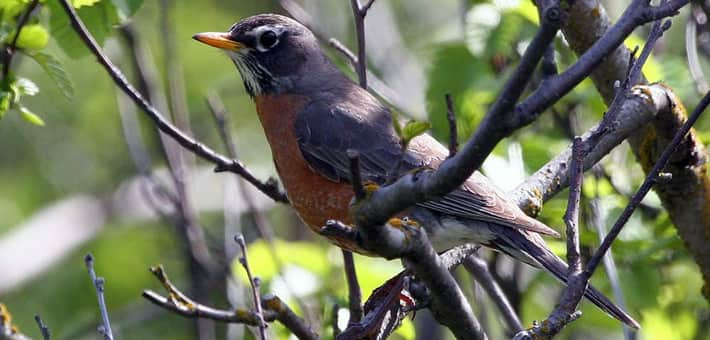50th Anniversary of Silent Spring: A Legacy Continues in Michigan for the U.S. Fish and Wildlife Service’s Environmental Contaminants Program
OutdoorHub 09.06.12

After years of witnessing American robins dying or dead on her lawn each spring, a St. Louis, Michigan, resident sent two dead robins to the Michigan Department of Natural Resources Wildlife Disease Laboratory. After examining the robins, the Michigan DNR sent the birds to a lab at Michigan State University where concentrations of DDT and its metabolites DDD and DDE were found in the robins’ brain tissue. Soon thereafter, on June 22, 2012, the headline in The Morning Sun, a central Michigan newspaper, read “Dead Robins in St. Louis Poisoned by DDT.” Yes, it was 2012 and, ironically, the same newspaper issue marked the 50th year since Rachel Carson “launched the environmental movement” by explaining the history and effects of pesticides on our nation’s wildlife in her book, Silent Spring. Her work led to a ban on the use of DDT in the United States.
The presence of DDT in Michigan robins is particularly chilling because the lethal impact of DDT on birds was first noted on Michigan State University’s campus decades ago. In Silent Spring, Rachel Carson chronicled the story of how ornithologist George Wallace helped connect the dots between broad-scale insecticide use and the silencing of spring’s harbinger, the robin. One of Dr. Wallace’s graduate students began studying robin populations in 1954, unrelated to insecticide use. DDT was being sprayed on elm trees throughout the campus to fight Dutch elm disease. That spring, robins arrived as usual, but over the course of the season and during the following years, dead and dying birds appeared on campus and surrounding suburbs; fewer and fewer robins were seen. Dr. Wallace first suspected a disease of the nervous system, but then “in spite of assurances from the insecticide people that their sprays were ‘harmless to birds’ the robins were really dying of insecticidal poisoning; they exhibited the well-known symptoms of loss of balance, followed by tremors, convulsions, and death.” Not all robins were killed. Dr. Wallace and others observed and documented that robins that managed to survive were not producing young.
Indications of the avenue of exposure – how DDT ended up affecting robins – started becoming evident after campus earthworms were inadvertently fed to crayfish and all the crayfish died; a snake in a lab cage fed campus earthworms went into violent tremors. A researcher at another university provided an explanation of the exposure route. DDT clung to leaves of treated elms. After leaf fall, earthworms incorporated leaves, with their DDT coating, into the soil as well as into their own bodies. Picked up by feeding robins, DDT then traveled from the earthworms to the birds and either killed them outright or concentrated in reproductive organs, preventing them from reproducing. Robins were not exposed to DDT through direct contact but by ingesting earthworms.
This and other stories in Silent Spring highlighted the effects of the indiscriminate use of pesticides immediately following World War II, prompting Rachel Carson to conclude that, “as crude a weapon as the cave man’s club, the chemical barrage has been hurled against the fabric of life – a fabric on the one hand delicate and destructible, on the other miraculously tough and resilient, and capable of striking back in unexpected ways.”
On June 19, 2012, 50 years after the release of Silent Spring, Environmental Contaminants Coordinator for the U.S. Fish and Wildlife Service, Dr. Lisa L. Williams (an MSU doctoral alum), was notified of the test results of the St. Louis, Michigan, robins. Based on her review of scientific literature that included Dr. Wallace’s work done at MSU in the 1960s, she verified that concentrations found in the robins was high enough to cause them to die. Dr. Williams passed the information on to the Michigan Department of Environmental Quality and the U.S. Environmental Protection Agency. As she reported“dead robins” and “DDT”, Dr. Williams paused and thought of Silent Spring. She, perhaps like many other Environmental Contaminants Specialists in the U.S. Fish and Wildlife Service, attributes the inspiration behind her career to Ms. Carson. Rachel Carson was a U.S. Fish and Wildlife Service employee and her legacy continues as we strive to serve the American people and address contaminant issues that impact fish and wildlife. At the core of the Service’s work is investigating the causes of observed effects and seeking ways to prevent or mitigate those effects.
The source of DDT in St. Louis, Michigan, is thought to be the former Velsicol Chemical plant that manufactured pesticides along the Pine River until 1978 and is currently a designated Superfund site. The yard where the robins were found is adjacent to the former plant. While a river cleanup led to decreased levels of DDT in fish, cleanup of the plant site itself has been a long process and cleanup of adjacent properties has yet to begin. The EPA and the Michigan DEQ are now moving forward with a cleanup plan for those areas. Soon, DDT levels at the plant and in adjacent resident soils will be reduced so that American robins are no longer silenced as they feed on area lawns.
Rachel Carson worked for the U.S. Fish and Wildlife Service from 1936 to 1952 and is recognized as one of the world’s foremost leaders in conservation. Her work as an educator, scientist and writer revolutionized America’s interest in environmental issues. In addition to sounding the warning about DDT in “Silent Spring,” she is remembered for her passion for the oceans and coasts, her inspiration as one of the first female scientists and government leaders, and her overall footprint on the history of conservation. To learn more, visit http://www.fws.gov/Midwest/es/ec/SilentSpring/

